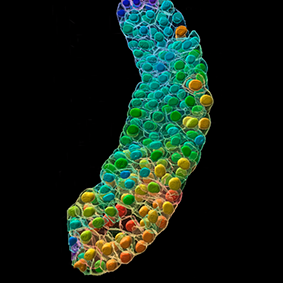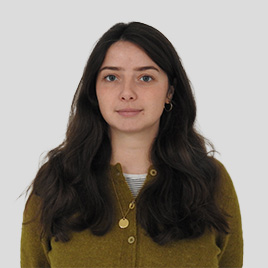Evolution and genetics
Virginie COURTIER-ORGOGOZO

Our research focuses on the mutations responsible for evolutionary change.
We use a combination of different approaches to identify the mutations responsible for evolutionary change and to reconstruct past evolutionary events. We hope that our work will provide new and rigorous data to better understand our evolution, past and future.
Keywords: evolution, species, Drosophila, genome, genetics, ecology, bioadhesive, development, QTL mapping
+33 (0)1 57 27 80 43 Contact @Biol4Ever https://courtier.ijm.fr/
Our research investigates the mutations responsible for evolutionary changes.
Since Darwin, research in evolutionary biology tries to understand biodiversity – the great number of species in nature, each with features so well adapted to its environment. In our current understanding of evolution, the genes and the mutations responsible for phenotypic differences have no distinctive features: mutations occur randomly and a few of them happen to spread in populations through selection and chance. However, phenotypic evolution may not be totally random in terms of genetics. There might be rules to be discovered about the mutations underlying natural evolution.
We are using a combination of various approaches to identify the mutations responsible for evolutionary changes and to reconstruct past evolutionary events. We hope that our work will provide new and rigorous data to better understand our evolution, past and future.
Evolution of fly glue (PI: V. COURTIER-ORGOGOZO)
 At the end of the larval stage, Drosophila larvae produce a proteinaceous glue that allows the animal to adhere to a substrate for several days during metamorphosis. We aim to use the powerful genetic tools of the model organism Drosophila melanogaster to explore the molecular basis for fly glue adhesion. We want to identify the genes involved in glue adhesion and understand how they have changed during evolution so that the glue can stick to various substrates in diverse environments. We developed a new assay to quantify Drosophila glue adhesiveness and we plan to measure adhesion of glue mutants and to compare adhesion between different Drosophila melanogaster populations and Drosophila species.
At the end of the larval stage, Drosophila larvae produce a proteinaceous glue that allows the animal to adhere to a substrate for several days during metamorphosis. We aim to use the powerful genetic tools of the model organism Drosophila melanogaster to explore the molecular basis for fly glue adhesion. We want to identify the genes involved in glue adhesion and understand how they have changed during evolution so that the glue can stick to various substrates in diverse environments. We developed a new assay to quantify Drosophila glue adhesiveness and we plan to measure adhesion of glue mutants and to compare adhesion between different Drosophila melanogaster populations and Drosophila species.
Evolution of left-right size asymmetry (PI: Michael LANG)
 How left-right asymmetries in organ size develop remains a mystery. Drosophila pachea has evolved a unique left-right asymmetry in genitalia lobes. No left-right size asymmetry has been described in D. melanogaster. We are trying to uncover the mechanisms that triger asymmetric lobe development and the role of these asymmetric lobes during copulation. We use a stock of Drosophila pachea containing spontaneous symmetric mutant males and we perform micro-scale laser removal of lobe bristles and micro-scale surgery of lobes. We are also examining left-right asymmetries in behavior and morphology in species closely related to D. pachea, in order to understand how left-right asymmetry in lobe size evolved in D. pachea.
How left-right asymmetries in organ size develop remains a mystery. Drosophila pachea has evolved a unique left-right asymmetry in genitalia lobes. No left-right size asymmetry has been described in D. melanogaster. We are trying to uncover the mechanisms that triger asymmetric lobe development and the role of these asymmetric lobes during copulation. We use a stock of Drosophila pachea containing spontaneous symmetric mutant males and we perform micro-scale laser removal of lobe bristles and micro-scale surgery of lobes. We are also examining left-right asymmetries in behavior and morphology in species closely related to D. pachea, in order to understand how left-right asymmetry in lobe size evolved in D. pachea.
Evolution of genitalia (PI: V. COURTIER-ORGOGOZO)
 We wish to understand how the morphology of genital organs change rapidly during evolution. We combine developmental studies, genomics, genetics, quantitative genetics, population genetics, microCT scans, laser microsurgery and behavioral experiments to understand how genes and cellular mechanisms modulate organ shape in a subtle and precise way, and how this can affect reproduction and long-term evolution. We examine the following genital organs: hypandrial bristles, ventral branches and posterior lobes.
We wish to understand how the morphology of genital organs change rapidly during evolution. We combine developmental studies, genomics, genetics, quantitative genetics, population genetics, microCT scans, laser microsurgery and behavioral experiments to understand how genes and cellular mechanisms modulate organ shape in a subtle and precise way, and how this can affect reproduction and long-term evolution. We examine the following genital organs: hypandrial bristles, ventral branches and posterior lobes.
The origin of COVID-19
Click here for more details.

Databases
Gephebase contains a list of all the genes and mutations that have been found to be responsible for phenotypic differences (morphological, physiological and behavioral traits) between populations or strains for pluricellular organisms. A preliminary list was deposited in Dryad in 2013 and the full open access website is available here
FlyPhenomics provides a compilation of the phenotypes that have been reported to differ between at least two species of the D. melanogaster subgroup. More than 150 morphological, physiological and behavioral differences have been described between 1919 and 2006.
associated paper: Orgogozo V, Stern DL, How different are recently diverged species? More than 150 phenotypic differences have been reported for the D. melanogaster species subgroup. Fly 2009 Mar-Apr;3(2):117.
FlyPNS :
description of the embryonic and larval peripheral nervous system of D. melanogaster.
made with Wesley Grueber.
associated paper: Orgogozo V, Grueber WB, FlyPNS, a database of the Drosophila embryonic and larval peripheral nervous system. BMC Dev Biol. 2005 Feb 17; 5(1):4.
Members
 Lou BABLEE, Intern, COURTIER LAB
Lou BABLEE, Intern, COURTIER LAB Wallys BIKOUMOU, Intern, COURTIER LAB
Wallys BIKOUMOU, Intern, COURTIER LAB Penelope DARNAT, Biology engineer, COURTIER LAB
Penelope DARNAT, Biology engineer, COURTIER LAB Alexis LALOUETTE, Assistant Professor, COURTIER LAB+33 (0)1 57 27 80 83, room 416B
Alexis LALOUETTE, Assistant Professor, COURTIER LAB+33 (0)1 57 27 80 83, room 416B Olga MENSHIKOVA, Intern, COURTIER LAB
Olga MENSHIKOVA, Intern, COURTIER LAB Isabelle NUEZ, Biology engineer, COURTIER LAB+33 (0)1 57 27 80 75, room 416B
Isabelle NUEZ, Biology engineer, COURTIER LAB+33 (0)1 57 27 80 75, room 416B
To contact a member of the team by e-mail: name.surname@ijm.fr
Lefèvre, B. M., Delvigne, M., Camprodon, A., Vidal, J., Courtier-Orgogozo, V., & Lang, M. (2025). Evolution of a novel left-right asymmetry in organ size by co-option of a tissue rotation process. Development, dev.204662. https://doi.org/10.1242/dev.204662
Monier, M., Lorenzi, J.-N., Narasimha, S., Borne, F., Contremoulins, V., Mevel, L., Petit, R., El Hachem, Y., Graner, F., & Courtier-Orgogozo, V. (2024). Adhesive and mechanical properties of the glue produced by 25 Drosophila species. Scientific Reports, 14(1), 23249. https://doi.org/10.1038/s41598-024-74358-9
Lorenzi, J.-N., Graner, F., Courtier-Orgogozo, V., & Achaz, G. (2024). CNCA aligns small annotated genomes. BMC Bioinformatics, 25(1), 89. https://doi.org/10.1186/s12859-024-05700-1
Monier, M., Nuez, I., Borne, F., & Courtier-Orgogozo, V. (2024). Higher evolutionary dynamics of gene copy number for Drosophila glue genes located near short repeat sequences. BMC Ecology and Evolution, 24(1), 18. https://doi.org/10.1186/s12862-023-02178-y
Chai, D., Mossadeq, L. E., Raymond, M., & Courtier-Orgogozo, V. (2023). Recommended distances for physical distancing during COVID-19 pandemics reveal cultural connections between countries. PLOS ONE, 18(12), e0289998. https://doi.org/10.1371/journal.pone.0289998
Courtier-Orgogozo, V. (2023). The loci of insect phenotypic evolution. Current Opinion in Insect Science, 60, 101134. https://doi.org/10.1016/j.cois.2023.101134
Elkin, J., Martin, A., Courtier-Orgogozo, V., & Santos, M. E. (2023). Analysis of the genetic loci of pigment pattern evolution in vertebrates. Biological Reviews of the Cambridge Philosophical Society. https://doi.org/10.1111/brv.12952
Courtier-Orgogozo, V., & de Ribera, F. A. (2022). SARS-CoV-2 infection at the Huanan seafood market. Environmental Research, 214(Pt 1), 113702. https://doi.org/10.1016/j.envres.2022.113702
van Helden, J., Butler, C. D., Achaz, G., Canard, B., Casane, D., Claverie, J. M., … & Halloy, J. (2021). An appeal for an objective, open, and transparent scientific debate about the origin of SARS-CoV-2. The Lancet. Featured in several newspapers including il Fatto Quotidiano Daily Mail ThePrint
Borne, F., Prigent, S.R., Molet, M., Courtier-Orgogozo, V. (2021) Drosophila glue protects from predation. Proc. R. Soc. B. 288: 20210088. doi: 10.1098/rspb.2021.0088 DRYAD Supp Data BioRxiv
Actualité CNRS
Courtier-Orgogozo V, Danchin A, Gouyon PH, Boëte C (2020) Evaluating the Probability of CRISPR-based Gene Drive Contaminating Another Species. Evolutionary Applications 00:1–18. doi: 10.1111/eva.12939 BioRxiv PDF
Borne F, Kovalev A, Gorb S, Courtier-Orgogozo V (2020) The glue produced by Drosophila melanogaster for pupa adhesion is universal. Journal of Experimental Biology 223: jeb220608 doi: 10.1242/jeb.220608 Published 23 April 2020. DRYAD BioRxiv Featured in “inside JEB“. PDF
Passion Entomologie
Courtier-Orgogozo V, Martin A (2020) The Coding Loci of Evolution and Domestication: Current Knowledge and Implications for Bio-Inspired Genome Editing. Journal of Experimental Biology 223: jeb208934. Published 7 February 2020. doi: 10.1242/jeb.208934 PDF HAL
Courtier-Orgogozo V, Martin A, Arnoult L, Prigent S, Wiltgen S (2020) Gephebase, a Database of Genotype-Phenotype Relationships for natural and domesticated variation in Eukaryotes. Nucleic Acid Research 48(D1), D696-D703. doi:10.1093/nar/gkz796 PDF HAL BioRxiv
Publications
Preprint
Review
Book chapter
Finished: Alexandre Peluffo, Flora Borne
Ongoing: Manon Monier
International
- Andolfatto, Columbia University, USA
- Martin, Georges Washington University, USA
- Matute, Chicago University, USA
- Santos, University of Cambridge, Cambridge, UK
- Schilthuizen, Leiden, Netherlands
- D.L. Stern, Janelia farm, Ashburn, USA
National
- Danchin, Paris
- Graner, Université Paris 7, Paris
- Montagné and T. Chertemps, Université Paris 6, Paris
- Morizot, Marseille
- Rode, Montpellier
- Wiltgen, Montpellier
- Labex “Who am I?”
- CNRS MITI 2020-2021 Adaptation du vivant
19/05/2025 : Virginie Courtier-Orgogozo, Officier dans l’Ordre National du Mérite
15.12.2023 : Epidémie: la bonne «distance de sécurité» est surtout une question de culture
28.10.2023 : De-extinction, un nouvel espoir ?
21.09.2023 : EDITO. Les indispensables de Sciences et Avenir : les mystères du vivant
The lab is recruting :
- Ingénieur / Ingénieure d’étude in molecular biology and genetics of Drosophila glue M/F: apply on the CNRS job portal before June 9th


